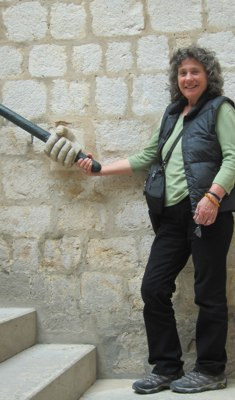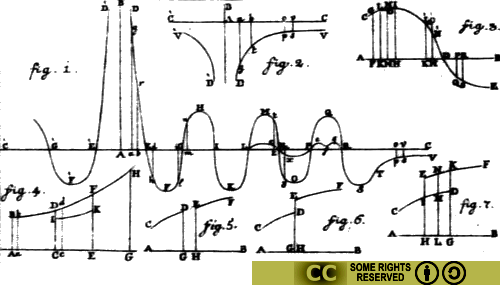| itinerary < Dubrovnik to Dubrovnik 11 October Trani, Puglie > | Dubrovnik 10 October 2011 |
Treasures of DubrovnikThere's one word that must be associated with Dubrovnik: CATS. We have seen more cats here than in the whole trip so far. Mostly strays, mostly chary of people and ratty looking. But when we engaged in one of the traveler's favorite tasks -- finding the laundromat and washing the dirties -- we were greeted by a lovely cheery washerwoman named Sjena (Shadow in Hrvastka, pronounced "Syena") and the local cat in charge, a charmer named Greta, who eventually allowed herself to be thoroughly skritched before bounding off to look statuesque in the sun on an unlikely perch where she really wasn't supposed to be. Something about the clothes washing experience makes for delightful interactions. The technology here is superb, too, with spiffy microcomputer controlled laundromats. Makes for happy washerpeople, we guess. In any case, both Greta and Sanja & Rosie's Laundromat count as treasures in our book. |
 |
 |
Carrying our nice clean clothes back through the PloÄe Gate, we walked right under Dubrovnik's patron saint, Sveti Vlaho (Saint Blaise), who can be seen to have the city in his hand. Vlaho appears everywhere in the city, from the niche above each gate to the Cathedral to a number of other prominent positions throughout the town. And it cannot be disputed, this place is a wonderfully favored one, by climate and topography, by the culture it has developed, and by many of its people. It is a place to be envied. Somehow, it sustains an onslaght of tourists, sometimes several thousand at a time, and seems mostly to keep its sense of humor and place. Let's give Sveti Vlaho the credit for that. However, it is not to be forgotten that in the fall and winter of 1991-1992 the city needed Sveti Vlaho's help, and even with it, heavy losses, both in treasure and in human lives, were suffered. This is a story with two wildly disagreeing sides, with a city caught in the middle. Twenty years later, some of the scars can still be seen, but many more can be felt, surprisingly, especially among the young who were not even born then. |
|
 |
 |
We visited the Serbian Orthodox church -- recently (in the 1800s) permitted in these sacred Catholic precincts, and a testimony of the permeability of even the racism that rules these parts. I would love to know who this somber fellow is -- he has surely seen a ration of suffering in his time, judging by those eyes. We lit candles, as the belief here is that it is the act, the thought, the prayer, no matter who the actor, thinker, or prayer. |
|
We visit the superb Ethnographic Museum in the old Rupe, or granary. There we were supervised closely, and taking pictures was strictly forbidden. (You know how I feel about that!) But there was this amazing Aga -- that's what it's called, and it's understood that the original Agas came from England and were horribly expensive. This one was built into a kitchen, and is in essence a masonry stove.
|

|
 |
The two guys up the clock now are copies; here, much restored, is the original Maro (or is it Baro) with his lovely iron hammer and intent, workmanlike bronze face. These guys work half a minute or so once an hour during the daytime... But they are reliable! The museums here -- there are three; we visited two -- are superb. Maro and Baro and the rest of the treasures on this page live in the Rector's Palace, the residence of the one-time governor of the Republic of Ragusa, of which Dubrovnik was the capital. The Rector, a government strategy copied from Venice and its Doges, served for a short period of time so that he could not implement strategies for personal gain. Nevertheless, the attitude here, as in Venice, was that governance was meant to improve and enhance the lives of all the people, not just a wealthy or fortunate few. This concept we find quite foreign (outside our Civics classrooms.) |
|
However, in case the Rector and his staff forgot, inscribed over the door was this simple reminder. It says, "Forget personal gain; care for the People." Europeans have a lovely habit of using public art like this to remind its leaders of their responsibility. Even so, there is an ongoing joke among the people here that this watchword is uniformly inverted by the leaders. Cycnicism about government appears to be universal in these parlous times. |
 |
 Rochelle enjoyed this visual pun. What have we here? Aha! A HAND rail! |
The railings here -- and there are many, because there are a lot of steps, and many of them are marble and slippery or ancient and worn or broken, or both -- are beefy, also built for the ages. The workers here worked iron the way we work wood ... and, as in this case, they are good with wood, too. And silver. Here's a silver service I wanted to bring home:
|

|
 | Ruđer Josip BoškovićThe Rector's Palace was hosting a special exhibition "celebrating the 300th anniversary of Croatia's polymath," RuÄ‘er Bošković. For those of you who have never heard of the guy, he was an outstanding example of the kind of broad-gauged intellectual that the Renaissance produced. He was, according to Wikipedia, a "theologian, physicist, astronomer, mathematician, philosopher, diplomat, poet, Jesuit..." The lucky child of an amazing explosion of erudition when a young guy, he was the very definition of a polymath. He measured the height of the Northern Lights, calculated the width of a degree at the equator, corrected the Church's notion of what made rainbows, adjudicated a hydrological dispute between the Tuscans and the Luccans, wrote 55 fabulous poems about the wonders of physics, made big breakthroughs in the study of statistics, drew the first map of the Papal States, invented the radial micrometer, concluded (and proved) there was no atmosphere on the moon, and – this one knocks my socks off – postulated the parallel relations between celestial objects like the moons of Jupiter and the elemental particles that make up matter, deducing that the fundamental particle (that we now call an atom) must be made up of three separate, different, and basically indivisible parts. |
|
All in one lifetime, ending in 1787. I guess if you were gonna make a splash, that was a good century to do it in! Here's the part of the first page of figures from RuÄ‘er's Theoria Philosophiæ Naturalis published in 1763. It is worth remembering that this was the time when Euler was struggling to deduce the elliptical orbits of comets, and Herschel has discovered the first outer planet, Uranus, based on perturbations of the orbits of inner planets. RuÄ‘er's mastery of mathematics – indeed, his intuitive grasp of the relationships between objects and numbers – put him in the right place to make huge contributions. |
 |
 |
The ongoing dissonance between good sense and unthinking racial intolerance that characterized the whole of western European thought gave birth to the sweet wall decoration at left. That this could co-exist in the same time and space as the high-flying thoughts of a Ruđer can either shock us and make us seethe, or amuse us with the innocence and beauty of the object without referencing the underlying injustice. It is, of course, just such inattention that brought on this event a mere two decades ago:
|
 |
Thoroughly steeped in the culture and history of this place, we stumbled out and found a restaurant, Ragusa 2, one of Dubrovnik's oldest and most highly regarded, where we had the worst, and one of the most expensive, meals of the trip so far. Surprising, since we'd had lunch at a lovely upstart vegetarian place, Nishta, that completely erased our misgivings about Makrovega in Split. We like it so much we went back today for lunch, and had a delicious bowl of salad from a surprisingly well-provisioned salad bar. A last day in Dubrovnik, ferry boarding passes in hand and no goals but to enjoy, we do: the "real city" outside the walls, a real natural foods store, a better market, fancy hotels built down the hillsides, little gemlike beaches ...then back to the marble streets, shows us that Dubrovnik is itself a treasure. We're onto a ferry this evening, where we'll go to sleep (we hope!) and while we sleep, our bed will move itself across the Adriatic and deposit us in Bari. Our Hrvatskan Odyssey has come to a very satisfactory conclusion. |
 |
updated 18 November 2024 Caspar Time site software and photographs by the Caspar Institute except as noted this site generated with 100% recycled electrons! send website feedback to the CI webster © copyright 2002-2024 Caspar Institute |